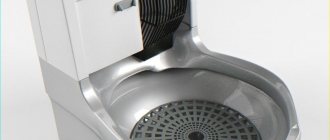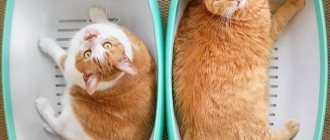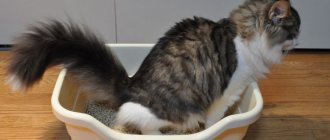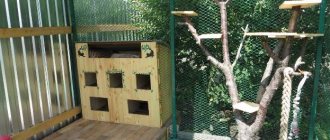- How to make a cat litter box with your own hands
- How to teach a cat to go to the litter box
- DIY scratching post
- How to get rid of cat odor
- plastic pallet or hard cardboard;
- self-adhesive film or piece of oilcloth;
The easiest way to make a toilet is from a plastic pallet. Take a mesh material (mosquito net or other), cut a rectangle according to the internal size of the tray, cover the edges with tape or self-adhesive film to prevent injuries when changing the toilet. Pour a 1-2 cm layer of sand or sawdust into the tray, cover with a homemade mesh and the tray is ready.
Instead of a metal mesh, you can make a mesh out of cardboard: cut out a suitable rectangle, cover it completely with film and make holes with an awl. The distance between the holes should be no more than 1 cm.
The mesh is needed to prevent the animal from getting its paws wet when urinating. It is easier to remove solid excrement from the screen than to flush it down the toilet along with lumps of sand. Simply brush the screen over the toilet and rinse.
The toilet can also be made from cardboard - cut a box of suitable size, strengthen it by covering it with film or oilcloth. A simple tray isn't enough? Decorate the toilet with a cat's head and letter stickers.
When cutting a tray from a cardboard box, make one side slightly larger than the rest. Cut out something like a cat's head (semicircle and ears) from the remaining cardboard and glue it to the elongated side. Cover the tray with film or oilcloth, and stick letters on the head element in the form of a cat’s name.
Share on social media networks:
Most cats in city apartments are constantly indoors. It is not customary to walk them like dogs. Therefore, arranging a “bathroom” for an animal is a must. For this reason, you need to choose a tray and filler for it with all responsibility. There are a large number of options for these products on sale, but you can make them yourself. Topic of the article: how to make a litter box for a cat with your own hands.
Requirements
Before you start working, you need to know which design is preferable. It is important to decide on the size, since the tray should be comfortable for the animal. Otherwise, it will simply do its business where it is more convenient. The pet should be able to take a comfortable position, therefore:
- The best option is a flat, oblong-shaped device.
- If your cat is shy by nature and prefers to cope with large and small needs, an enclosed “house” would be a good solution.
- The depth of the future “toilet” should be no less than 50, but no more than 70-80 mm. If the tray is too shallow, then the filler, swelling, will spill out through the sides.
Important! For animals that like to rummage through the litter, higher sides are desirable. A tray designed for a small kitten should be small in height so that the baby can easily climb in and out of the tray.
As for the material of manufacture, then:
- It is advisable that your DIY cat tray be made of plastic. This is a durable, affordable, and, most importantly, extremely easy-to-care material. It is extremely easy to wash and clean.
- In principle, metal is also a suitable option, but it quickly oxidizes, reacting with the animal’s urine.
- Wood is only suitable for temporary use, as it quickly swells, absorbs moisture, and a constant aroma reigns in the apartment, which is quite difficult to get rid of. For the same reason, a cardboard box for a cat’s “latrine” is not the best option.
How to make a toilet for a cat with your own hands: plastic design
Making a plastic “toilet” for a cat is not at all difficult and does not take long. Some complicated tools won't be useful either. So, to make a “latrine” for a catfish, you will need:
- Plastic container (bath, construction basin).
- Marker, masking tape.
- Hacksaw. It can be replaced with a jigsaw or grinder.
- Coarse sandpaper or file.
- Acrylic paint.
- Take a suitable plastic container.
- Mark the cut location with a marker or tape. You choose the height of the sides yourself, depending on the age, size and individual characteristics of your pet predator.
- Cut off all excess using a jigsaw, hacksaw or grinder. It is not advisable to use scissors for this purpose, as the material may crack.
- Clean the cut areas with sandpaper or a file.
- If desired, paint the container with acrylic paint (preferably from a spray can).
Important! If you take a closed plastic container and cut an entrance into it, you will get a cozy “toilet-house” for a shy pet.
Cat screen
Such a screen, neatly installed in a place hidden from view, is a stylish and elegant way to provide your pet with privacy.
What you will need
- White cardboard exhibition stand of three sections.
- The fabric is light or medium weight.
- Hot glue gun and glue sticks.
How to do it
- Lay the fabric face down on a flat surface (the piece should be larger than the stand).
- Place the stand face down in the middle of the fabric.
- Wrap the excess fabric around the sides and corners of the stand as if you were wrapping a gift.
- Tape all four corners around the edges of the stand. Press and hold for a minute or two to allow the fabric to adhere.
When choosing a fabric, choose one that is easy to clean, not too heavy, and not too thin. An inexpensive tablecloth will work well, or you can buy fabric that matches your curtains.
DIY wooden cat tray
As already mentioned, this is a temporary option. You can use a box made of plywood or boards as a “bathroom” for the mustachioed tabby.
So, you will need:
- Boards or plywood sheets.
- File, jigsaw.
- Screwdriver.
- Screws or self-tapping screws.
- Metal corners.
- Thick waterproof film.
The procedure is as follows:
- Make a sketch or drawing of the future product, taking into account the dimensions and configuration. It can be a rectangle or a triangular structure (for placement in a corner).
- Cut out 3 or 4 (depending on the configuration) sides for the future tray. Fasten them together using screws or self-tapping screws.
- Cut out the bottom and attach it to the frame using corners.
- Cover the bottom of the product with film and fill it with filler.
DIY wooden cat tray
The mesh toilet is very easy to use. It can be used with or without filler. To use a litter box with a cat grid, follow these steps:
- the container is installed in a secluded place, but so that the animal has round-the-clock access to it (for example, under the bathroom);
- filler or simple sawdust is poured into the tray tray so that it covers the bottom (if liquid gets on them, the granules swell greatly, so you should not overdo it with the quantity);
- A mesh is placed on top of the tray and the toilet is ready for use.
Making a plastic “toilet” for a cat is not at all difficult and does not take long. Some complicated tools won't be useful either. So, to make a “latrine” for a catfish, you will need:
- Plastic container (bath, construction basin).
- Marker, masking tape.
- Hacksaw. It can be replaced with a jigsaw or grinder.
- Coarse sandpaper or file.
- Acrylic paint.
- Take a suitable plastic container.
- Mark the cut location with a marker or tape. You choose the height of the sides yourself, depending on the age, size and individual characteristics of your pet predator.
- Cut off all excess using a jigsaw, hacksaw or grinder. It is not advisable to use scissors for this purpose, as the material may crack.
- Clean the cut areas with sandpaper or a file.
- If desired, paint the container with acrylic paint (preferably from a spray can).
As already mentioned, this is a temporary option. You can use a box made of plywood or boards as a “bathroom” for the mustachioed tabby.
So, you will need:
- Boards or plywood sheets.
- File, jigsaw.
- Screwdriver.
- Screws or self-tapping screws.
- Metal corners.
- Thick waterproof film.
The procedure is as follows:
- Make a sketch or drawing of the future product, taking into account the dimensions and configuration. It can be a rectangle or a triangular structure (for placement in a corner).
- Cut out 3 or 4 (depending on the configuration) sides for the future tray. Fasten them together using screws or self-tapping screws.
- Cut out the bottom and attach it to the frame using corners.
- Cover the bottom of the product with film and fill it with filler.
The toilet is ready!
Requirements
Before you start working, you need to know which design is preferable. It is important to decide on the size, since the tray should be comfortable for the animal. Otherwise, it will simply do its business where it is more convenient. The pet should be able to take a comfortable position, therefore:
- The best option is a flat, oblong-shaped device.
- If your cat is shy by nature and prefers to cope with large and small needs, an enclosed “house” would be a good solution.
- The depth of the future “toilet” should be no less than 50, but no more than 70-80 mm. If the tray is too shallow, then the filler, swelling, will spill out through the sides.
As for the material of manufacture, then:
- It is advisable that your DIY cat tray be made of plastic. This is a durable, affordable, and, most importantly, extremely easy-to-care material. It is extremely easy to wash and clean.
- In principle, metal is also a suitable option, but it quickly oxidizes, reacting with the animal’s urine.
- Wood is only suitable for temporary use, as it quickly swells, absorbs moisture, and a constant aroma reigns in the apartment, which is quite difficult to get rid of. For the same reason, a cardboard box for a cat’s “latrine” is not the best option.
Basic nuances of choosing a tray
So, today manufacturers of cat litter boxes offer a wide range, and many future owners are faced with the problem of how to choose a cat litter box. There are open and closed models, there are automatic ones and those that require mechanical cleaning. It is important to choose exactly the type that your pet will like.
To understand which cat toilet is more suitable, you should pay attention to the following nuances:
- Material of manufacture - it is important to choose a durable product and quite weighty so that it does not spread to the cat.
- Shape and size - the toilet should have a shape and size that allows you to move freely in it.
- Depth - a cat litter box should have a depth that allows it to be filled with the required amount of litter, which at the same time will not be scattered when buried.
- Smoothness of the surface - the surface of the product must be free of defects in the form of sharp protruding elements that can cause injury to the pet.
Pros and cons of using
This tray, like any other thing, has its advantages and disadvantages. Main advantages:
- This toilet model is inexpensive, and in addition, the owner will be able to save on filler.
- Since the filler is completely hidden in the tray, the cat will not be able to reach it and taste it.
- Compared to conventional plastic toilets, this tray option is more hygienic. After all, thanks to the grate, the pet does not come into contact with dirty litter and does not spread it throughout the house on its paws.
- Variety of colors. A person can choose just such a cat litter box with a grate that would fit into the interior of the apartment.
- Daily washing. The grate of the litter box will have to be washed every time your pet uses the restroom. Otherwise, it will get dirty with the products of its vital activity, and an unpleasant smell will hang in the apartment.
- A cat litter box with a grid is suitable only for those owners who spend their time mainly in the house. If you do not wash the mesh in time, the animal may refuse to relieve itself again in a dirty tray, and this is fraught with “surprises” in the most unexpected places.
- Smell. If you do not use fillers, then such an open tray will invariably emit not the most pleasant odors.
The last disadvantage can be easily avoided. You just need to add wood filler to the tray; it absorbs moisture and retains odors.
Sand
Sand absorbs moisture quite well. It copes with the smell somewhat worse: it weakens it, but does not absorb it completely. Therefore, if you use sand as a filler, you will have to come to terms with the fact that the toilet will almost always smell like cat urine. In addition, the grains of sand are very light - therefore, when the animal buries traces of its vital activity, the floor next to the tray will be covered with sand. However, this trouble can be avoided by using high trays with sides. The sand in the cat litter box is replaced every 2-4 days.
How to change the filler correctly?
If there is no opportunity for regular washing, then to avoid odors it is worth using cat litter. In the pet store they are presented in a wide range of different materials:
- Silica gel absorbs liquid better than other granules and absorbs odors. It is made from dry silicate gel, so it is toxic. It is not recommended to use it in apartments where small kittens live. They can taste it, and in addition, the silica gel granules begin to fizz when they get wet. This may frighten your pet.
- Wood filler is also effective in controlling odors. Absorbing liquid, its granules increase in size by 2-3 times. Therefore, you need to pour it in small quantities, which allows you to save a lot.
- Mixed clay and sawdust filler. Despite the fact that it copes well with the task, it also has disadvantages. It is also not suitable for kittens, as they may swallow it. And when they react with liquid, the granules become wet and can stick to the pet’s fur.
- Regular sawdust. Sawdust blocks odor quite well, but is significantly inferior in this regard to wood filler.
- Sand. River sand only absorbs moisture, but does not eliminate the odor at all, so you have to change the filler often.
Of the options listed, the most versatile would be wood filler. It can be used for kittens and adults, for healthy animals and animals prone to allergies. But if several individuals live in the house, then the best way to deal with the smell is silica gel.
Cats rarely do anything out of spite, so if the owner finds a puddle in the wrong place, he should not scold the cat. You just need to change the filler and monitor your pet’s reaction.
The frequency of changing the filler depends on its type. For example, wood pellets that have been exposed to urine will scatter at the bottom of the tray. They are separated with a spatula from the surviving granules and thrown away. If there are no whole ones left, then remove all sawdust from the tray and wash it well under running water.
You can use cat litter, such as silica gel, for two weeks and only then change it completely. But it is better to remove already used lumps immediately. And the contents of the tray need to be stirred periodically for quick drying.
The mixed filler is also changed once a week. To do this, you need to use a special spatula with holes through which the used filler will be sifted from the clean one. After this procedure, fresh granules are added to the container.
In addition, wet cleaning will be required around the tray, as grains of sand may spill outside of it. Each owner can decide for himself how much filler to add by observing the animal.
Required amount of filler per cat:
- wood filler - 1 layer;
- silica gel - 2 cm in height;
- mixed - 3 cm;
- sand - 1 cm.
All types of fillers have different granule sizes. This is convenient because you can buy small stones for kittens, in which they will rummage with interest, and this will help them quickly get used to the toilet.
Original ideas on how to hide a cat's litter box
Cat litter is unsightly and sometimes smelly, it's generally a nuisance, but if you have a cat, you have to have cat litter. Every cat owner wonders where the best place to place the cat litter box is. And yet, when the tray catches your eye, it involuntarily causes a grimace. It's time to fix it! Look at these unusual ideas for hiding cat litter and smile, and maybe some will even be useful.
Cat litter on the bench
Such a bench, purchased at a hardware store, furniture store or online store, has space that can be used for a cat litter box. There is also a separate compartment for filler. It has holes in the sides to ensure sufficient ventilation. One door can be closed to hide the filling compartment from view.
Hide cat litter in the cabinet
Living in a small apartment has several challenges, including the problem of placing a toilet for your furry pet. Is there a place for it and extra space to hide a less-than-aesthetic item? Make your own cabinet where you can place it. When the doors are closed, no one can even guess what is hidden there.
Curtains will hide the excess
This idea can be a beautiful way to hide your cat's litter box. Bright fabric will enliven a small table and become a comfortable place for your pet. You can use Velcro strips to open the curtain to make it easier for your cat to get in. However, it's easy enough to lower down and your guests will be sure that you just updated a boring piece of furniture.
To make such a box for a cat, you don't need any special skills. Simply join two wooden boxes together and cut an opening large enough for your kitten to enter comfortably. If you secure it with hinges, the design will be more convenient.
Lovers of pets and plants will definitely love this item! The cat litter was perfectly camouflaged under a flower pot. It can be painted in the color that will match your interior.
Don't rush to throw away your old small cabinet. Simply refresh the paint and place everything you need for your pet. There is enough space for a tray, and filler, food, bowls and various small items will be hidden on the shelf.
Do you want to install a cat litter box in a small bathroom? Cut a hole in the cabinet under the sink and place a box inside. Then the toilet will not get in the way and will be easy for both your cat and you to get to in order to clean it up. Such a curly neckline will be especially interesting.
IKEA idea for hiding cat litter
Oh IKEA, what would we do without you? This time we took one of the plain white cabinets, cut a hole in the side and installed a damper for added odor control. You would never guess that this is a cat litter box.
Who says you have to buy something to hide your cat's litter box? If you have certain skills, make your own house with a removable roof and it will be as convenient as a wardrobe or bench.
This bright blue box will impress cat lovers!
To make such a box for a cat, you don't need any special skills. Simply join two wooden boxes together and cut an opening large enough for your kitten to enter comfortably. If you secure it with hinges, the design will be more convenient.
How to train a cat to use a litter box?
When a tray and filler have been chosen, the main question arises - how to train the cat to do its business in exactly the right place. You can teach this to a cat of any age, but it is easier to do this when there is a kitten in the house.
After this, the kitten can be periodically brought into the tray and made digging movements with its paws. If during the day the owner notices that the pet has begun to rush about and behave restlessly, he should also take the animal to the tray. When a cat successfully goes to the toilet in the litter box, he must be encouraged.
It will be a little more difficult to train an adult, as it already has its own character and habits. They are shown the toilet according to the same principle as kittens. If the cat has chosen a toilet in another place, you can pick up her excrement with a scoop and transfer it to the tray. If this does not help, you can try to place the tray where the cat did its business and gradually move it to its original place, about 5 cm per day.
If your pet refuses to go to the designated place, you should not yell at him or scold him too much. Ultimately, your efforts will bear fruit.
- How to make a cat litter box with your own hands
- How to teach a cat to go to the litter box
- DIY scratching post
- How to get rid of cat odor
- plastic pallet or hard cardboard;
- self-adhesive film or piece of oilcloth;
The easiest way to make a toilet is from a plastic pallet. Take a mesh material (mosquito net or other), cut a rectangle according to the internal size of the tray, cover the edges with tape or self-adhesive film to prevent injuries when changing the toilet. Pour a 1-2 cm layer of sand or sawdust into the tray, cover with a homemade mesh and the tray is ready.
Cat litter can be divided into several types:
Natural (street, parks, sandboxes) - no training required, but they are only available to cats from the private sector.
Tray toilets . Containers made of metal or plastic into which filler is added: from budget sand or newspapers to very high-tech odor-absorbing materials!
Aerobatics - the cat goes into the owner's toilet (or sink). This requires some training skills, or special attachments for toilet training cats. But at once it eliminates problems with fillers, odor, periodic disinfection of the tray, and also saves money!
The tray can be bought in a store, or made from scrap materials: wood or plastic, as shown in the video
What requirements must a cat litter box meet?
To choose the best toilet for your pet, you need to evaluate the following parameters:
- Size and strength. You should not buy a tray for growth, because it is difficult for the baby to climb over the high sides. When choosing a device, you need to check its strength so that it does not bend under the weight of your palm. You should not buy a container that is too large, for which it is difficult to find a secluded place in the apartment.
- Safety. A quality product does not smell. To ensure the safety of the material, you need to ask the seller to provide a product quality certificate. The surface of the structure must be smooth. Sharp edges that could injure the animal are not allowed.
Closed toilet house
- Ease of cleaning. It is necessary to avoid purchasing products with recesses and an uneven surface: they are difficult to wash, since plaque forms in hard-to-reach places and recesses. To make toilet maintenance easier, it is recommended to pay attention to electric self-cleaning models. Of course, automatic toilets also need to be washed periodically, and they are much more expensive than classic trays, but thanks to them, there is practically no unpleasant odor from cat feces and urine in the apartment.
- Hygiene. For an adult cat, you need to choose a box with high sides: even the neatest pet scatters the litter, so you need to place a rubber mat in front of the tray. For animals that zealously dig into pellets, it is recommended to buy a closed toilet in the form of a house.
Main types of toilets
a variety of cat litter trays on their shelves Some of them involve the use of filler, others have a plug-in grille for liquid drainage. Often, products for pet hygiene procedures are divided into two large groups: open and closed toilets. Depth, size and shape can also be criteria for distinguishing them. In order to make the right purchase of a cat litter box, it is necessary to study the nuances of using different types of this product.
Ordinary plastic one-piece tray
A fairly common and popular model is a one-piece plastic tray . It is a rectangular product with low sides. Often no additional accessories are included with it. The main advantages of this type include low cost and compactness. It is also easy to maintain. If a kitten chooses a toilet, then this is an excellent model: it’s not at all difficult for a baby to climb into a tray of this type.
If the toilet is chosen for an adult cat, then this is by no means the best option: the shallow depth causes constant chaos in the place where the toilet is located. To prevent the litter from being thrown out when buried, it is better for adult pets to choose one of the following types, such as a litter box for cats with a mesh, a tray with high sides, or a closed model. Also, the disadvantages include the possibility of using this option only with filler.
Tray with high sides
A tray with high sides is similar to a regular one-piece plastic model, but is equipped with removable sides. This additional parameter can be used to fix the film, which can be easily removed after the pet has relieved itself. This makes the product easier to maintain: there is no need to wash anything.
Another advantage of this model is its depth: thanks to the ability to raise the sides to the required level, the cat will not scatter the litter beyond the boundaries of its litter box. This type makes it possible to use both filler and film. But there is also a disadvantage when using this version of the tray: it is much larger than the product described above, so it requires more space.
Tray with mesh
The next type of cat litter with a mesh is also similar to an ordinary plastic model, only a mesh is placed on top of the product. Thanks to the use of this accessory, all excrement passes through the grate into the tray, and the pet’s paws remain clean and dry.
No filler is required to use this option. But this is the reason for the disadvantage of this model, which is the impossibility of neutralizing the smell and its further spread throughout the apartment. Therefore, after each management of the pet, it is necessary to clean it. In addition, it is worth adding that not all cats like this type of toilet. This is due to the situation when a cat’s claws get caught in the bars when the burrowing instinct manifests itself, and she herself gets scared.
Tray house for cats
Many owners prefer a closed cat litter box or, in other words, a litter box. This product is comfortable to use for both the owner and the animal. Some models even have doors that prevent odors from spreading from the tray. But not every cat likes such an accessory.
It is worth noting that a closed toilet has a number of advantages over other toilet options:
- the product perfectly retains the “aromas” inside it;
- many pets love an enclosed space that gives them a sense of security;
- the filler does not end up outside the boundaries of the tray when buried;
- the cat does not accidentally walk past the toilet, unlike open litter boxes.
The disadvantage of this type relates not to operation, but to cost. Due to the high price, not every owner can purchase a toilet house for a cat.
Automatic tray
, automated closed toilets for cats are on sale . They represent a real advancement in the cat litter industry. The products fit aesthetically into the bathroom of the house. And they don’t require much effort to keep the pot clean. Naturally, the cost of a self-cleaning cat litter box is quite high. But if there are a large number of animals in the house and there is no time to clean up after them, this model becomes the best option. The disadvantages of the automated option include the loud sound produced by the product during the cleaning period.
Classic pet tray with and without filler: pros and cons
This model of cat litter is the most popular and is a rectangular, or less often triangular, plastic container. Trays are available with and without bars, but in the latter case, the use of filler is mandatory. Advantages of the classic design:
- compactness;
- ease of use and cleaning;
- economical operation - models with a grill can be used without filler, but they need to be washed more often;
- low price.
When choosing a classic tray, you need to remember its disadvantages:
- the need for daily cleaning;
- the cat scattering granules near the box while digging for litter;
- the risk of injury to the pet due to claws touching the bars;
- feces getting stuck in the tray grid;
- unaesthetic.
Fuel granules (pellets)
Wood pellets intended for solid fuel boilers are wood processing waste pressed into granules and are practically no different from wood fillers for cat litter. When wet, they crumble into small sawdust and absorb moisture and odor just as effectively. The pellets are poured into the tray in a thin layer; as they are used, their volume increases 4-5 times. If you use pellets, you can clean the tray once every 7-10 days.
How does a self-cleaning smart toilet work?
This model involves periodic self-cleaning of excrement. The automatic cat litter box makes noise during operation, so the system starts the cleaning process some time after the pet has gone to the toilet. Depending on the degree of automation of cleaning, there are 2 types of “smart” toilets:
Self-cleaning litter box for cats
- Fully autonomous models . These automatic cat litter boxes are connected to the power grid, central water supply and sewerage system and operate according to a schedule set by a person. Touch sensors monitor the humidity level of the litter and the presence of the pet in the toilet and start the cleaning process 10-15 seconds after the animal leaves it. These toilets are valued for their maximum ease of use, which does not require constant human attention, but are expensive and require uninterrupted operation of communication systems.
- Semi-automatic models. In this case, the toilet is connected only to the electrical network. An electronic device periodically sifts the litter, removing excrement into a waste drawer and liquid into a reservoir. These models cost less than stand-alone ones, but to operate them you need to buy special bags for collecting feces. Semi-automatic toilets need to be cleaned periodically: liquids daily, feces weekly.
Cat toilet with drainage: models, operating principle, cost
The most popular automatic toilet for cats with drainage is called “CatGenie 120” and is a round toilet with a special washable filler. The liquid is flushed down the drain immediately after the pet goes to the toilet, and the feces are first collected with a scoop with holes and crushed, and then removed. Next, the toilet bowl and granules are washed with soapy water and dried under warm air. The price of this system ranges from 30–35 thousand rubles.
More affordable (costing about 10 thousand rubles) is the Kopfgescheit sensor automatic toilet. The cleaning function starts 15 seconds after the pet leaves the toilet. The duration of drainage depends on the type of waste: to clean the container from urine, the system operates for 4 seconds, from feces - 6 seconds. This automatic toilet does not require any filler to use, but it does require more water to flush than the previous model.
In order for them to last as long as possible, they need to be cleaned every six months, as plaque forms in the system and wool, dirt, etc. accumulate. Special gels are used for cleaning, but in no case are cleaning products with abrasive particles.
How to make a comfortable tray for your pet with your own hands?
It is preferable to make a rectangular box in which it is most convenient for the pet to fit. Regardless of the model chosen, the depth of the container for an adult cat should be within 5–8 cm. It is better to use plastic for its manufacture, since metal oxidizes, and wood gets wet and absorbs unpleasant odors. How to make a cat litter box yourself?
Plastic toilet similar to a regular tray
To work, you need to prepare tape or a marker, a hacksaw or jigsaw, coarse sandpaper or a file, acrylic paint, a plastic container - a construction basin or a medium-sized bath. To make a tray, you need:
- mark the cut location on the wall of the container - the height of the future box, depending on the size of the cat;
- carefully, so that the plastic does not crack, cut off the excess;
- file the edges so that the animal does not get hurt;
- if desired, paint the product.
To make a closed toilet with minimal financial and time costs, you can take a plastic box with a lid and make a hole in one of its walls through which the animal should easily pass. The edges of the passage also need to be filed. When choosing a container, you need to check whether the pet can sit and turn around freely in it.
Newspapers
Newspapers torn into small pieces are an old “folk” way of arranging a cat’s litter box, very popular, but at the same time quite troublesome. To make it convenient for your cat to use the tray, you need to tear the paper quite finely, but it gets wet very quickly. You have to change the paper in the tray every day, or at most every other day, and it doesn’t cope with the smell very well.
You can purchase the tray with the lattice – then the moisture will drain down and the newspaper will get wet more slowly. To avoid odour, to empty this tray it is necessary several times a day.
Which toilet is better to choose for a kitten?
Kittens begin to be toilet trained at 3–4 weeks. Small containers with low sides that they can easily step over are suitable for kids. The main thing is to choose a safe filler, for example from pressed wood or cereals, that does not cause allergies in kittens. When the kitten grows up, you need to choose a larger tray for him, depending on his preferences: an open classic model, a box hidden in a cabinet or placed in a closed house - for shy pets.
Share on social media networks:
Most cats in city apartments are constantly indoors. It is not customary to walk them like dogs. Therefore, arranging a “bathroom” for an animal is a must. For this reason, you need to choose a tray and filler for it with all responsibility. There are a large number of options for these products on sale, but you can make them yourself. Topic of the article: how to make a litter box for a cat with your own hands.
Sawdust
Sawdust is a good alternative to factory-made fillers. They are easy to dig, they retain both moisture and smell well - such a tray begins to smell only when all the sawdust becomes wet. Therefore, sawdust is one of the best types of “folk” fillers. If you use a tray with high sides and sprinkle sawdust in a layer of 8-10 centimeters, you can clean the cat litter box every 5-7 days. True, there are also some inconveniences: sawdust generates dust, in addition, the smallest particles of wood “stick” to the cat’s paws and are spread throughout the apartment.
On top of the sawdust, you can put a thin layer of pieces of Newspapers – then the dirt on the floor will be less. To change the soaked paper should be daily.
Requirements
Before you start working, you need to know which design is preferable. It is important to decide on the size, since the tray should be comfortable for the animal. Otherwise, it will simply do its business where it is more convenient. The pet should be able to take a comfortable position, therefore:
- The best option is a flat, oblong-shaped device.
- If your cat is shy by nature and prefers to cope with large and small needs, an enclosed “house” would be a good solution.
- The depth of the future “toilet” should be no less than 50, but no more than 70-80 mm. If the tray is too shallow, then the filler, swelling, will spill out through the sides.
Important! For animals that like to rummage through the litter, higher sides are desirable. A tray designed for a small kitten should be small in height so that the baby can easily climb in and out of the tray.
As for the material of manufacture, then:
- It is advisable that your DIY cat tray be made of plastic. This is a durable, affordable, and, most importantly, extremely easy-to-care material. It is extremely easy to wash and clean.
- In principle, metal is also a suitable option, but it quickly oxidizes, reacting with the animal’s urine.
- Wood is only suitable for temporary use, as it quickly swells, absorbs moisture, and a constant aroma reigns in the apartment, which is quite difficult to get rid of. For the same reason, a cardboard box for a cat’s “latrine” is not the best option.
How to make a toilet for a cat with your own hands: plastic design
Making a plastic “toilet” for a cat is not at all difficult and does not take long. Some complicated tools won't be useful either. So, to make a “latrine” for a catfish, you will need:
- Plastic container (bath, construction basin).
- Marker, masking tape.
- Hacksaw. It can be replaced with a jigsaw or grinder.
- Coarse sandpaper or file.
- Acrylic paint.
- Take a suitable plastic container.
- Mark the cut location with a marker or tape. You choose the height of the sides yourself, depending on the age, size and individual characteristics of your pet predator.
- Cut off all excess using a jigsaw, hacksaw or grinder. It is not advisable to use scissors for this purpose, as the material may crack.
- Clean the cut areas with sandpaper or a file.
- If desired, paint the container with acrylic paint (preferably from a spray can).
Important! If you take a closed plastic container and cut an entrance into it, you will get a cozy “toilet-house” for a shy pet.
DIY wooden cat tray
As already mentioned, this is a temporary option. You can use a box made of plywood or boards as a “bathroom” for the mustachioed tabby.
So, you will need:
- Boards or plywood sheets.
- File, jigsaw.
- Screwdriver.
- Screws or self-tapping screws.
- Metal corners.
- Thick waterproof film.
The procedure is as follows:
- Make a sketch or drawing of the future product, taking into account the dimensions and configuration. It can be a rectangle or a triangular structure (for placement in a corner).
- Cut out 3 or 4 (depending on the configuration) sides for the future tray. Fasten them together using screws or self-tapping screws.
- Cut out the bottom and attach it to the frame using corners.
- Cover the bottom of the product with film and fill it with filler.










